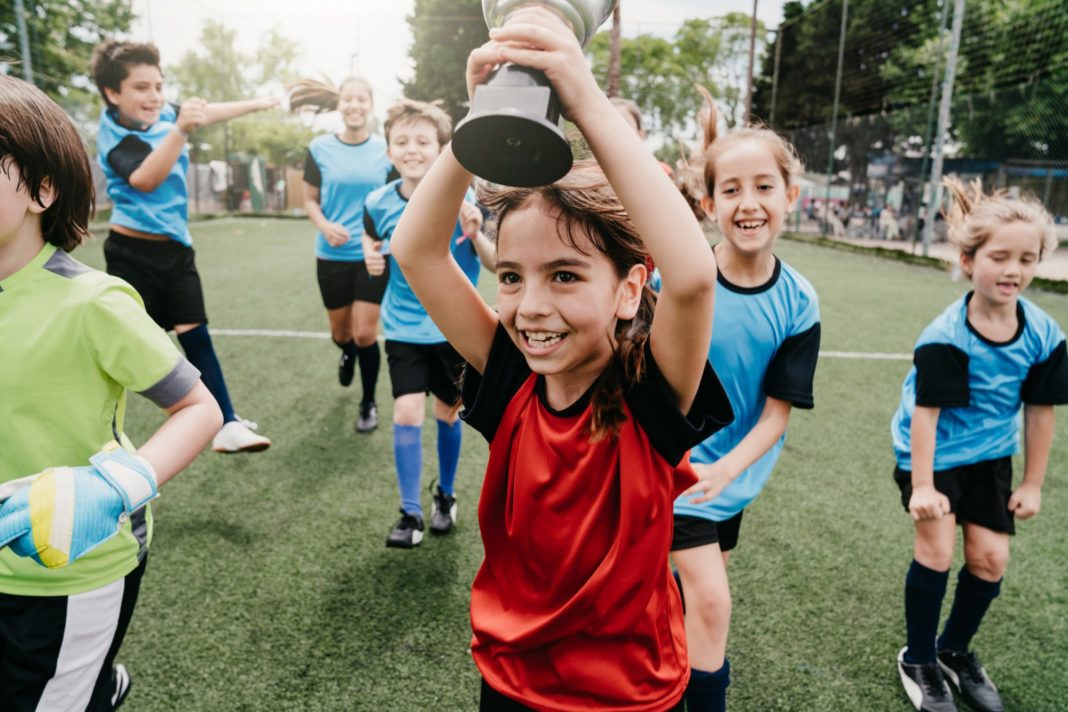
With the warmer weather and some states relaxing mask mandates and occupancy limits of different buildings and events, many kids are eager to get back to their favorites spring sports and physical activities. But if your child has COVID-19 or had it in the past, you may wonder when it's safe for them to return to sports. Here's what experts recommend to get kids safely back to exercise after COVID-19.
Can You Exercise with COVID?
If your child has COVID-19, they should take it easy. "We recommend that all people with active COVID-19 infection refrain from strenuous exercise," says Cheyenne Beach, M.D., a pediatric cardiologist at Yale New Haven Children's Hospital in New Haven, Connecticut. That goes for everyone, those who have symptoms and those who are asymptomatic.
"Exercising while infected with COVID-19 increases the risk of inflammatory cardiac and pulmonary complications," says Troy M. Smurawa, M.D., Director of Pediatric Sports Medicine at Children's Health Andrews Institute in Plano, Texas. So they should hold off on intense exercise until after they've recovered.
That said, your kid doesn't have to just sit or lay around all day. As long as your child follows feels well and follows isolation rules, exercises like yoga, walking, and casual play are healthy and encouraged, says Dr. Beach.
Once all symptoms have gone away and the quarantine period is over, your child shouldn't immediately jump back into sports or exercise after COVID-19. "The American Academy of Pediatrics (AAP) recommends that people, even asymptomatic, be seen by their primary care medical team following their quarantine period for discussion and clearance to return to physical activities," says Dr. Beach. Your kid might whine about it, but this guideline is in place for an important reason. It allows the body to heal from the virus and increases the likelihood that any effects on the heart would be identified before the child (or adult, for that matter) returns to exercise, Dr. Beach explains.
When Can You Exercise After Having COVID?
"The timeline for returning to sports after having COVID-19 depends on the severity of the person's symptoms and their overall health," Dr. Smurawa says.
The AAP has provided the following interim guidance:
If your child was asymptomatic or had only mild symptoms (fewer than four days of fever, and less than one week of chills, fatigue, and muscle aches):
If your child had a moderate illness (fever for four or more days, symptoms lasting a week or longer, and/or a non-ICU hospital stay, with no evidence of multisystem inflammatory syndrome in children (MIS-C):
If your child had severe COVID-19 symptoms that required hospitalization in the ICU or was diagnosed with MIS-C:
How to Return to Exercise After COVID
Younger kids appear to be less affected by COVID-19 and their exercise and sports tend to be less intense and taxing on the heart than that of adolescents. Therefore, the AAP says once children under age 12 have met isolation requirements, are symptom-free and cleared by the doctor, they can return to PE classes and sports as their tolerance allows.
For older kids whose exercise and sports are generally more strenuous, a gradual approach is best. This allows time to identify any symptoms that could be potentially related to cardiac issues, says Dr. Beach.
It also reduces the chances that your child will be sidelined by an injury shortly after returning to play. "Inactivity during the quarantine period leads to decreased cardiorespiratory fitness, muscle strength and endurance as well as a loss of sports-specific skills," Dr. Smurawa explains. If your child tries to jump back in at the level they were at before COVID-19, or do too much too quickly, it puts them at risk for injuries.
There are many variations of the return-to-play protocol, but a widely accepted one is to follow a weeklong schedule that gradually increases the intensity and duration of exercise, says Dr. Beach, who is part of New Haven Children's Hospital's Cardiology COVID-19 Return-to-Play Program.
For a child who plays soccer, Dr. Beach says a gradual return may look like the following:
Can You Exercise After Getting the COVID Vaccine?
After getting the jab, some people may experience pain at the injection site, headache, chills, tiredness, muscle pain, joint pain, or fever. If you have any of these side effects, you may want to take it easy for a couple of days.
But for most people, there's no reason to put off exercise after getting the COVID-19 vaccine. "As long as you're feeling well and have no other need to avoid exercise, we encourage you to keep your body and mind healthy with activity," says Dr. Beach. If you're up for it, you can get in a workout the same day.
As for kids exercising after getting the COVID-19 vaccine, there's not yet an answer. There are currently no COVID-19 vaccines approved for use in younger children (the Pfizer vaccine is approved for people ages 16 and older), but clinical trials are underway. Experts will be able to provide guidance once a vaccine is approved for use in children.
How to Keep Your Child Safe When Returning to Sports
Symptoms to Look Out For
As your child returns to sports, it's important to be on the lookout for complaints of chest pain, rapid or uncomfortable heartbeat, shortness of breath out of proportion to the level of exercise, dizziness, or passing out, says Dr. Beach. If your child experiences any of those or other concerning symptoms, have them stop the activity and check with their doctor immediately.
Even if your child already had COVID, they can get it again. Therefore, it's important to try to reduce the risk of reinfection. Some things to consider when choosing an activity for your child are the type of sport, where it occurs, the number of players involved, whether the sport allows for physical distancing, and whether it requires travel.
"Outdoor activities are better than indoor activities," says Neysa Ernst, R.N., MSN, a nurse manager of the biocontainment unit at Johns Hopkins Hospital in Baltimore, Maryland. Activities that allow players to maintain a safe physical distance, such as singles tennis, are less risky than sports that require close contact like basketball or wrestling. Also, "travel contributes to the spread of COVID-19, so if you must travel, be vigilant," Ernst says. She advises asking if travel is absolutely required.
Keep Following Safety Protocol
Regardless of the sport you and your child choose, make sure everyone is following COVID-19 safety procedures. "Talk with the coaches and the other families to make sure you have a team approach to COVID-19 risk reduction," says Ernst. All children, coaches, and parents should wear a face mask and maintain physical distance, and practice proper hygiene measures, including handwashing and/or use of hand sanitizer. Team members shouldn't share water bottles, towels, or sports equipment (when possible).
"Observe the team at practice and during events to make sure that they are using good sound science, including social distancing, masking, and doing elbow bumps instead of handshakes," says Ernst. Bring any concerns to the coach's attention, and if your child develops symptoms of COVID-19, notify the coach immediately. Keep them home until cleared by the pediatrician.
Stay Informed
"In the past year, we've learned a lot about the cardiovascular risks of COVID-19 infection in children, and we're constantly learning and adapting our care to reflect what we know," says Dr. Beach. That means guidelines and recommendations will likely change. Therefore, it's important to keep up to date with the rapidly changing information and discuss any questions with your primary medical team, Dr. Beach says.
































